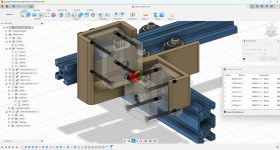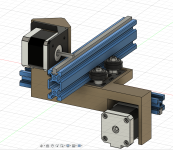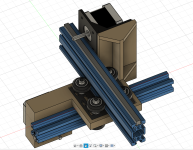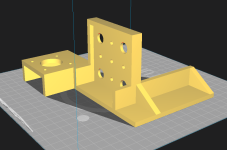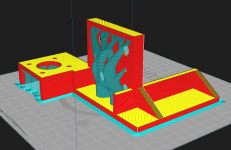Nope, this is the direct drive approach.Still chasing the T-bot idea?
If I push it I might get 80cm, but I don't see the need for my table top prototype.
I agree. It is mostly a proof of concept. So we greedy onlookers can copy and get it moving!If I push it I might get 80cm, but I don't see the need for my table top prototype.
Hi Bill!How about a belt (or chain) with a normally-on clamp on it?
We have looked at belts, and Delrin or POM gear racks. Kind of leaning to gear racks as it is easier to keep a position with a motor that is off.
https://www.aliexpress.com/item/100...ene:pcDetailBottomMoreOtherSeller|query_from:
Might be rather useful for our endeavors with worm gear, stepper all in one. Solves any problems with moving as a worm gear is self braking. Torque will be rather sufficient. This coupled with the correct rack and gear and it's fairly simple no?
Might be rather useful for our endeavors with worm gear, stepper all in one. Solves any problems with moving as a worm gear is self braking. Torque will be rather sufficient. This coupled with the correct rack and gear and it's fairly simple no?
Next mistake:
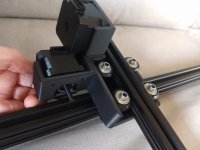
The motors touch...
Encouraged by my CAD progress I tried to incorporate the different parts in Fusion. Models for the profile and steppers are freely available.
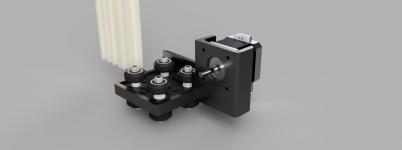
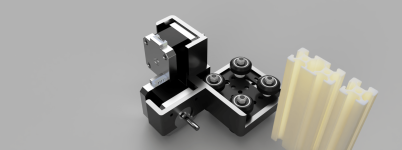
And indeed the steppers don't fit...
Making steps in all kinds of directions. Still lots to learn and lots to do; progress is slow.

The motors touch...
I personally would first make up the design, either a simple sketch or in CAD, get an understanding where all the important parts and sections are and than come up with what to get.
Encouraged by my CAD progress I tried to incorporate the different parts in Fusion. Models for the profile and steppers are freely available.


And indeed the steppers don't fit...
Making steps in all kinds of directions. Still lots to learn and lots to do; progress is slow.
Tom I am watching, and taking notes mentally. Note to self. Motors smacking into each other.... badd.....
I can see that you have worked out where you had interference between the motors and the rolling platform. This is making design sense. What I am thinking now is stiffness. That may only be able to be tested when you have this all made and determine that with a mic at full extension everything is sitting correctly and not sagging due to much weight and a not robust enough dual motor bracket.
So is there after 6 years of sometimes very interesting, but mostly BS information, a room exclusing measurement system? Apart from that Klippel thingie, of course 🙂. I did several hours of reading but I have no clue. Prolly my bad 🙂. If that Klippel can get rid of the room it would be a goddamn gift to humanity because you could trow all that crappy room correction software out and have perfect solution.
A double bass array gets rid of a load of interfering freqs. And that Ascend boss on ASR claims he has a MLSSA system that is room corrected so he can measure very low, as long as the workers don't alter the room, with klippel resolution, way faster as klippel does it. And the Bruno, Kii fame, has also something alike.
.
A double bass array gets rid of a load of interfering freqs. And that Ascend boss on ASR claims he has a MLSSA system that is room corrected so he can measure very low, as long as the workers don't alter the room, with klippel resolution, way faster as klippel does it. And the Bruno, Kii fame, has also something alike.
.
An interesting approach in this camera sliderDoes anyone see any obvious improvements/rearrangements I'm missing?
A strange opening lineSo is there after 6 years of sometimes very interesting, but mostly BS information, a room exclusing measurement system?
How do ya reckon...?... be a goddamn gift to humanity because you could trow all that crappy room correction software out and have perfect solution.
...
//
A very strange post all together, because this entire system doesn't have much to do inroom response, but about measuring loudspeakers.A strange opening line
Two different animals
There is a lot of food for thought there. The belt drive is simple.An interesting approach in this camera slider
Printing the parts, or having them printed is not impossible.
Once Tom has something that gets the motion down I am excited to try and get this all together.
One this for Eric to answer. How long are the test regimes?
Oh and signal types? If Klippel uses a swepped sine wave or some other combined signal for their LSI measurements?
An interesting approach in this camera slider
A strange opening line
You measure the sound the speaker generates in 2 positions and you can exclude the room. So when you use the same speaker and you know how to exclude the room it doesn't matter if you play sweeps or music to get rid of the room. 😎How do ya reckon...?
//
Aha - you mean how to exclude the room ala' Klippel - but why in the same sentence use the word "room correction" - thats what confused me and make ni sense at all in this context... or?
//
//
- Home
- Design & Build
- Software Tools
- Klippel Near Field Scanner on a Shoestring
